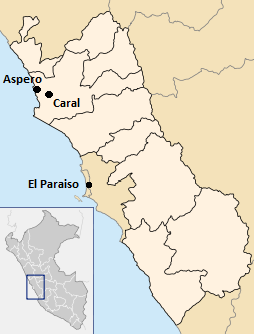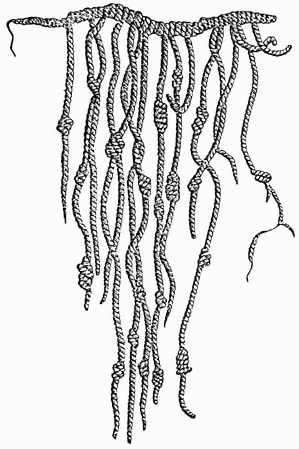The Norte Chico civilization
The Norte Chico civilization, also known as the Caral-Supe civilization, is one of the oldest known complex societies in the Americas. Flourishing between approximately 3000 BCE and 1800 BCE along the arid coast of modern-day Peru, Norte Chico represents an early cradle of civilization in the New World. Distinguished by monumental architecture, complex societal organization, and a reliance on maritime and agricultural resources, it predates more widely known Mesoamerican and Andean civilizations like the Maya and Inca.

Monolith in Caral. Source: Wikimedia Commonsꜛ (license: CC BY-SA 3.0)
Origins and early development
The Norte Chico civilization emerged in a region characterized by a desert environment interspersed with fertile river valleys, including the Supe, Pativilca, and Fortaleza rivers. These rivers provided the necessary resources to sustain agricultural communities. Early settlements utilized irrigation systems to cultivate crops such as cotton, squash, and beans, while maritime resources like anchovies and sardines played a crucial role in their economy.

Map of Caral–Supe sites showing their locations in Peru. Source: Wikimedia Commonsꜛ (license: CC BY-SA 3.0)
Caral, one of the most prominent sites, exemplifies the sophistication of Norte Chico society. Dating back to approximately 2600 BCE, Caral features large ceremonial platforms, sunken plazas, and evidence of organized urban planning. Unlike many other ancient civilizations, Norte Chico appears to have developed without a written language or pottery, relying instead on textiles and quipu-like recording systems for communication and record-keeping.

Panorama of Caral. Source: Wikimedia Commonsꜛ (license: CC BY-SA 4.0)
Cultural achievements and society
The Norte Chico civilization is best known for its monumental architecture. The site of Caral contains six large pyramidal structures, with the largest measuring over 60 feet in height. These constructions indicate a high level of social organization and the ability to mobilize labor for public works. The sunken circular plazas found at many sites suggest the importance of communal and ceremonial activities.

Reconstruction of one of the pyramids of Aspero. Source: Wikimedia Commonsꜛ (license: CC BY-SA 4.0)

Remains of platform mound structures at Caral. Source: Wikimedia Commonsꜛ (license: CC BY-SA 3.0)
Despite the lack of a writing system, Norte Chico society displayed considerable complexity. The quipu, a system of knotted cords, may have served as an early form of record-keeping or communication, predating its extensive use by the Inca. The emphasis on textiles and weaving further highlights their cultural ingenuity.

Remains of the two main Caral pyramids in the arid Supe Valley. Source: Wikimedia Commonsꜛ (license: CC BY-SA 3.0)
Socially, Norte Chico appears to have been a stratified society with a ruling elite overseeing construction projects, ceremonial activities, and resource distribution. The absence of fortifications suggests a relatively peaceful society focused on communal cooperation and religious rituals.

The presence of quipu tentatively suggests a []”proto-writing” system](/weekend_stories/told/2024/2024-12-22-brief_history_of_writing/) in ancient Caral–Supe. Quipu are recording devices fashioned from knotted cords used by a number of cultures in the central Andes Mountains of South America. They were used to record quantitative information such as population data, tax obligations, and calendar events. Source: Wikimedia Commonsꜛ (license: public domain)
Religious practices and economy
Religion played a central role in Norte Chico society. The construction of monumental architecture and ceremonial plazas reflects their spiritual worldview, likely centered on agriculture, water, and celestial phenomena. The presence of fire pits and evidence of offerings indicates the use of ritual practices to maintain cosmic harmony and societal cohesion.

Altar of the Holy Fire, on top of the Templo Mayor. Source: Wikimedia Commonsꜛ (license: CC BY-SA 3.0)
Economically, Norte Chico relied on a dual subsistence strategy combining agriculture and marine resources. Cotton cultivation was particularly significant, supporting the production of fishing nets and textiles. This reliance on both land and sea resources facilitated trade and interaction with neighboring communities, establishing Norte Chico as a regional hub of innovation and exchange.

The people from the Caral–Supe civilization used vertebrae of the blue whale as stools. Source: Wikimedia Commonsꜛ (license: CC BY-SA 3.0)
Comparisons with other civilizations
The Norte Chico civilization illustrates how early societies in distinct environments developed unique solutions to the challenges of sustaining complex cultures. While civilizations in Mesopotamia and Egypt utilized fertile river valleys, Norte Chico relied on a maritime-agricultural economy, combining coastal resources with inland farming. Their monumental platforms and plazas, designed for ceremonial purposes, reflect a universal human tendency to create sacred spaces.
Regionally, Norte Chico stands out as one of the earliest Andean societies, laying a foundation for later civilizations such as the Moche and the Inca. Unlike the more hierarchical and militaristic Inca Empire, Norte Chico appears to have been relatively egalitarian, focusing on communal projects and innovation in textiles. While they lacked pottery and writing, their use of quipu for record-keeping hints at cultural continuities that would later shape Andean civilizations.
Norte Chico’s emphasis on large-scale cooperative efforts and sustainable resource management underscores its importance in understanding early human societies. Its achievements challenge traditional definitions of “civilization”, offering valuable insights into the diverse pathways of societal development.
Decline and legacy
The decline of the Norte Chico civilization around 1800 BCE remains a topic of scholarly debate. Environmental changes, resource depletion, and shifts in trade networks may have contributed to its eventual fade. However, its cultural innovations, particularly in communal labor organization, textile production, and early record-keeping, influenced subsequent Andean civilizations.
Norte Chico’s legacy lies in its role as one of the first complex societies in the Americas. Its achievements in monumental architecture, resource management, and societal organization provide critical insights into the origins of civilization in the New World.
References
- Michael E. Moseley, The Incas and Their Ancestors: The Archaeology of Peru, 2001, Thames & Hudson, ISBN: 978-0500282779
- Ruth Shady, Caral: The First Civilization of the Americas, 2010, Christopher Paul Kleihege, ISBN: 978-9972337925
- Charles Stanish, Ancient Andean Political Economy, 2011, University of Texas Press, ISBN: 978-0292729452
- Richard L. Burger, Chavin and the Origins of Andean Civilization, 1995, Thames & Hudson, ISBN: 978-0500278161
- Jeffrey Quilter, The Ancient Central Andes, 2013, Routledge, ISBN: 978-0415673105
- Nigel Davies, The Ancient Kingdoms of Peru, 1998, Penguin Books, ISBN: 978-0140233810
- Deborah L. Nichols and Christopher A. Pool (Eds.), The Oxford Handbook of Mesoamerican Archaeology, 2016, Oxford University Press, ISBN: 978-0190230807
- Helaine Silverman and William H. Isbell (Eds.), Andean Archaeology III: North and South, 2008, Springer, ISBN: 978-0387757308















comments